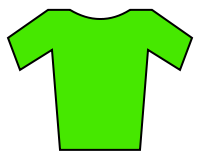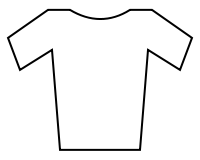1984 Tour de France
| Race details |
| Dates |
29 June–22 July 1984 |
| Stages |
23+Prologue |
| Distance |
4,020.9 km (2,498 mi) |
| Winning time |
112h 03' 40" (34.906 km/h or 21.690 mph) |
| Palmares |
 |
Winner |
 Laurent Fignon (France) Laurent Fignon (France) |
(Renault) |
|
Second |
 Bernard Hinault (France) Bernard Hinault (France) |
(La Vie Claire) |
|
Third |
 Greg LeMond (United States) Greg LeMond (United States) |
(Renault) |
|
 |
Points |
.svg.png) Frank Hoste (Belgium) Frank Hoste (Belgium) |
(Europ Decor) |
 |
Mountains |
 Robert Millar (United Kingdom) Robert Millar (United Kingdom) |
(Peugeot) |
 |
Youth |
 Greg LeMond (United States) Greg LeMond (United States) |
(Renault) |
 |
Sprints |
 Jacques Hanegraaf (Netherlands) Jacques Hanegraaf (Netherlands) |
(Kwantum Hallen) |
|
Team |
Renault |
|
Team Points |
Panasonic |
The 1984 Tour de France was the 71st Tour de France, run over 4020.9 km in 23 stages and a prologue, from 29 June to 22 July 1984.[1]
French rider Laurent Fignon won his second consecutive Tour, beating former teammate Bernard Hinault by over 10 minutes. Hinault was pursuing his fifth Tour victory after having sat out the 1983 Tour because of injuries. Also that year, Greg LeMond became the first American rider to finish in the top three and stand on the podium. Belgian cyclist Frank Hoste won the points classification, and British Robert Millar won the mountains classification. The race consisted of 23 stages, totaling 4,020 kilometers (2,500 mi).
Differences from the 1983 Tour de France
Before the 1984 Tour, the Intermediate sprints classification did not have a jersey. In the 1984 Tour, the organizers gave the leader of the classification a red jersey to wear.[2]
For the first time, the Société du Tour de France organized the Tour de France Féminin, a version for women.[notes 1] It was run in the same weeks as the male version, and won by Marianne Martin.[3]
Participants
There was room for 18 teams in the 1984 Tour de France; in early 1984, there were 17 candidate teams. Although the Tour organisation approached AVP-Viditel and Metauromobili, an 18th team was not added.[4] The 1984 Tour started with 170 cyclists, divided into 17 teams of 10 cyclists:[2]
Race details
The 1984 Tour de France was a battle between Fignon and his former team captain Hinault. Hinault won the prologue, but Fignon won back time when his team won the team time trial in stage three.[5] After a large escape in the fifth stage, Fignon's team mate Vincent Barteau was leading the race. In the seventh stage, Fignon won the time trial, beating Hinault by 49 seconds.[6] Barteau was still leading the race, and remained the leader after the Pyrenées.
In the sixteenth stage, Fignon again beat Hinault in a time trial, this time winning 33 seconds.[7] In the seventeenth stage, Hinault attacked five times on the penultimate climb, but every time Fignon was able to get back. Then, Fignon left Hinault behind, and won almost three more minutes on Hinault. Barteau was so far behind in this stage, that Fignon became the new leader.[8] Fignon won three more stages, for a total of five that year, and won the Tour with a ten minute margin. With his air of indifference in interviews and his crushing dominance, he was hailed as France's newest superstar.
Stages
The 1984 Tour de France started on 29 June, and had one rest day, in Grenoble.[9]
Results
There were several classifications in the 1984 Tour de France, six of them awarding jerseys to their leaders. The most important was the general classification, calculated by adding each cyclist's finishing times on each stage. The cyclist with the least accumulated time was the race leader, identified by the yellow jersey; the winner of this classification is considered the winner of the Tour.[11]
Additionally, there was a points classification, where cyclists were given points for finishing among the best in a stage finish, or in intermediate sprints. The cyclist with the most points lead the classification, and was identified with a green jersey.[11]
There was also a mountains classification. The organisation had categorized some climbs as either hors catégorie, first, second, third, or fourth-category; points for this classification were won by the first cyclists that reached the top of these climbs first, with more points available for the higher-categorized climbs. The cyclist with the most points lead the classification, and was identified with a polkadot jersey.[11]
There was also a combination classification. This classification was calculated as a combination of the other classifications, its leader wore the combination jersey.[12]
Another classification was the debutant classification. This was decided the same way as the general classification, but only riders that rode the Tour for the first time were eligible, and the leader wore a white jersey.[11]
The sixth individual classification was the intermediate sprints classification. This classification had similar rules as the points classification, but only points were awarded on intermediate sprints. Its leader wore a red jersey.[13]
For the team classification, the times of the best three cyclists per team on each stage were added; the leading team was the team with the lowest total time. The riders in the team that lead this classification wore yellow caps.[14]
There was also a team points classification. After each stage, the stage rankings of the best three cyclists per team were added, and the team with the least total lead this classification, and were identified by green caps.[12]
General classification
Team classification
Final team classification (1–5)[15]
| Rank |
Team |
Time |
|---|
| 1 | Renault | 336h 31' 16" |
| 2 | Skil | +46' 44" |
| 3 | Reynolds | +57' 58" |
| 4 | Peugeot | +1h 01' 57" |
| 5 | La Vie Claire | +1h 15' 59" |
Team points classification
Final team points classification (1–3)[15]
| Rank |
Team |
Points |
|---|
| 1 | Panasonic | 1159 |
| 2 | Renault | 1318 |
| 3 | Peugeot | 1322 |
Intermediate sprints classification
Notes
- ↑ A race for female cyclists similar to the male Tour de France had been organized in 1955, but it was not official.
References
- General
- Specific
- ↑ Augendre, Jacques (2009). "Guide Historique" (PDF) (in French). Amaury Sport Organisation. Archived from the original on 2009-10-09. Retrieved 12 May 2010.
- ↑ 2.0 2.1 2.2 2.3 "71ème Tour de France 1984" (in French). Memoire du cyclisme. Retrieved 15 August 2011.
- ↑ "Tour de France féminin" (in French). Memoire du Cyclisme. 23 November 2008. Retrieved 27 March 2012.
- ↑ "Zeventien formaties kandidaat voor Tour". Nieuwsblad van het Noorden (in Dutch) (Koninklijke Bibliotheek). 26 January 1984. p. 21. Retrieved 29 December 2013.
- ↑ McGann, p. 147
- ↑ McGann, p. 148
- ↑ McGann, p. 150
- ↑ McGann, p. 152
- ↑ Augendre, Jacques (2009). "Guide Historique, Part 4" (PDF) (in French). Amaury Sport Organisation. Archived (PDF) from the original on 9 July 2010. Retrieved 17 June 2010.
- ↑ Zwegers, Arian. "Tour de France GC Top Ten". CVCC. Archived from the original on 2009-06-10. Retrieved 15 Aug 2011.
- ↑ 11.0 11.1 11.2 11.3 Christian, Sarah (2 July 2009). "Tour de France demystified - Evaluating success". RoadCycling.co.nz Ltd. Retrieved 27 April 2012.
- ↑ 12.0 12.1 Mark, Eddy van der. "Tour Xtra: Other Classifications & Awards". Chippewa Valley Cycling Club. Retrieved 27 April 2012.
- ↑ Mark, Eddy van der. "Tour Xtra: Intermediate Sprints Classification". Chippewa Valley Cycling Club. Retrieved 27 April 2012.
- ↑ Chauner, David; Halstead, Michael (1990). The Tour de France Complete Book of Cycling. Villard. ISBN 0-679-72936-4. Retrieved 27 April 2012.
- ↑ 15.0 15.1 15.2 15.3 15.4 "Clasificaciones oficiales". El Mundo Deportivo (in Spanish). 24 July 1984. Retrieved 18 March 2012.
- ↑ "Tour in cijfers". Leidsch Dagblad (in Dutch) (Regionaal Archief Leiden). 23 July 1984. p. 14. Retrieved 18 March 2012.
|
|---|
| | |
- Prologue–Stage 11
- Stage 12–23
|
|